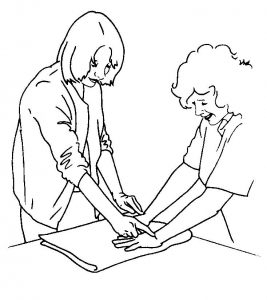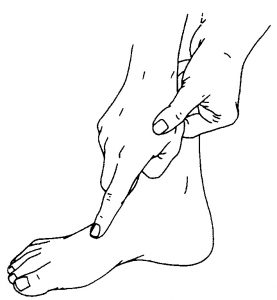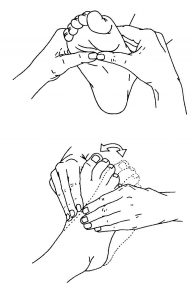
What is Reflexology and how
does Vertical Reflexology work?
Reflexologists do not claim to diagnose , cure or prescribe. Reflexology is a very individual treatment which is tailored to you as a whole person, taking into account both physical and non-physical factors that might be affecting your well-being. Reflexology is a safe and non-invasive therapy as no instruments are used, and only the feet and hands are touched. It is suitable for clients of all ages, from young babies to older and infirm persons, and is used to support everyone from professional sports persons to end of life care situations.

Vertical Reflexology and the development of the Vertical Reflexology Technique (VRT)
A VRT trained reflexologist will work on your weight-bearing feet and hands for a few minutes per treatment to accelerate the healing processes brought about in conjunction with early reflexology treatments. The client then lies on a couch and relaxes for their classical reflexology session which also incorporates new techniques from the VRT repertoire.
Several weekly treatments are usually needed before the body’s mechanism is stimulated enough to bring about a definitive change in a condition.
However, some clients may notice an improved sense of well-being almost immediately, and once health is regained, periodic visits are recommended as a preventative measure to balance and harmonise the body.
There have been some positive research projects carried out with reflexology; however, as yet, there is not a large enough body of evidence for us to make clinical claims of effectiveness.
Vertical Reflexology is adaptable
for all ages and conditions



All reflexologists are aware of the difficulties in treating disabled clients, especially those in wheelchairs.
Since the early 1990’s Lynne Booth has held a weekly reflexology clinic at the St Monica Trust, Bristol which is a large sheltered housing and nursing home complex for older clients. She found it was often it was impossible to work the reflexes on the soles of the feet so, out of necessity, she began to work the top or dorsum of the feet as they rested on wheelchair foot supports . She began to notice some wheelchair-bound clients reported that they they felt generally more relaxed and some commented on other general health improvements on an individual basis.
The concept of VRT was formally introduced globally by Lynne Booth following this client incident:
A 74-year-old woman was injured in an accident and had limited mobility. She was too frail to undergo a hip replacement operation due to chronic angina.
Her right leg and hip were in extreme pain, and Lynne Booth decided to apply 90 seconds of reflexology to the dorsum of her feet while she was in a standing, weight-bearing position. Within 24 hours, she felt much more relaxed and found she was able to move her foot and leg higher than she had done for months.
Lynne felt that the missing link was that the feet had to be fully weight-bearing for the reflexes to become receptive to treatment. Within 10 weeks, the woman’s general health appeared to have improved and this resulted in better mobility.She also reported that she felt generally much more relaxed


Lynne Booth has written two books on the subject for hands and feet, including the best-selling Vertical Reflexology, and she lectures on VRT internationally, as well as running a private practice in Bristol. In 2011 the Institute of Complementary and Natural Medicine (ICNM) presented Lynne Booth with a Highly Commended award for her Outstanding Contribution to Complementary Medicine. In 2018 Lynne was the winner of the prestigious AoR Excellence in Reflexology Innovation award. She has also run a clinic at the St Monica Trust for older people for 25 years and worked as reflexologist to a Championship Football team for 15 years.
If you’d like to find a VRT practitioner in your area, please click the button below.

